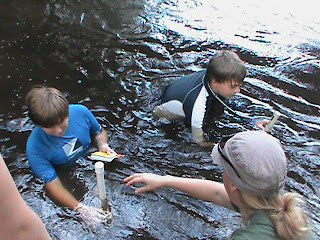Splash into Science!
 |
As Plymouth State University Graduate Student, Ashley Hyde looks on, two campers deploy electrical conductivity and stage pressure sensors in the Ashuelot River (Keene, NH)
|
“Splash
into Science” was exactly what students did during their Kids On Campus program
at Keene State College two weeks ago.
Steve Hale and I were fortunate enough to facilitate 11 middle school students
during the week long session based on the LoVoTECS network data. Students
learned how to define a watershed and several ways to assess water quality.
Campers battled mosquitoes and lugged sledge hammers, waders, specific
conductance meters, PVC housing, rebar and other equipment out to our site on
the Ashuelot River to deploy a set of HOBO data loggers. Like the LoVoTECS
network, sensors were set to collect temperature, electric conductivity (EC)
and water pressure measurements at 3 minute increments. Macroinvertebrates were
also collected in buckets and brought back to the classroom for classification.
The faces of damselfly larva shocked students at first glance under the
dissecting microscopes. The data from macroinvertebrate inventory was combined
with the sensor data in order to draw a general conclusion of the Ashuelot’s
quality of water. To the students’ surprise, EC levels were 100s of microsiemens
lower than their predictions. In order to solidify the concept of how humans
influence water quality within watersheds, students participated in a water
pollution and land cover graphing activity with Skittles as well as Watershed
Bingo. My favorite activity of the week was a concept analysis of the term
“watershed.” On the first day of camp, prior to any ground-laying
conversations, students were asked to draw a watershed. A majority of them drew
an image of a shed with some sort of pipe system inside. On the last day of
camp, students were asked to draw a watershed again. This time, their drawings
included rivers, tributaries, and mountains along the perimeter, farms,
factories, roads and bridges. It was clear that all students had a solid
understanding of how to define the term. The students showed off their new
vocabulary and summarized their findings by creating posters for a poster
session for their parents and guardians. It was really neat to see the students
articulate what they had learned during the week. We are working on packaging
this week-long curriculum so it may be used in future camps or classroom
settings.
Posted by Ashley Hyde, Graduate Student Plymouth State University and Stephen Hale, Research Associate, University of New Hampshire Joan and James Leitzel Center
Posted by Ashley Hyde, Graduate Student Plymouth State University and Stephen Hale, Research Associate, University of New Hampshire Joan and James Leitzel Center
No comments:
Post a Comment